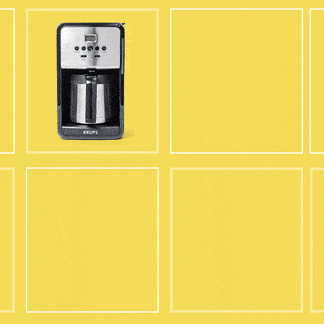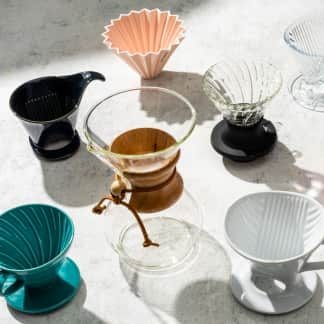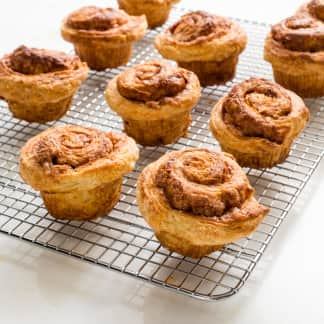A good French press makes it easy to brew delicious coffee. The best choice depends on your preferences. For an insulated press, the Stanley Classic Stay Hot French Press, 48 oz has a wide, sturdy stainless-steel pot and feels secure and smooth to press. It made excellent coffee and stayed piping hot for more than an hour. Our co-winner, Bodum Columbia Insulated French Press Coffee Maker, 34 oz, shared these attributes. If you drink coffee right after brewing it, our Best Buy Bodum Chambord French Press Coffee Maker, 34 oz is a classic glass-carafe press that’s simple to use; the uninsulated glass keeps coffee hot for about 30 minutes. If you prefer coffee with less of the typical French-press “grit,” choose Espro P7 French Press, with its multiple filters and gaskets that remove extra sediment.

The French press (or cafetière à piston, as the French call it) is an immersion coffee maker. Water and coffee steep for several minutes in the pot before you push a piston-like filter mechanism to force the ground coffee to the bottom, leaving full-bodied brew on top. With oils and tiny particles of the grind suspended in the drink, classic French press coffee is rich, thick, and impossible to confuse with drip coffee.
As a brewing method, French press offers benefits: It takes no electricity; unlike pour-over brewing, you add all the water at once; you need never buy coffee pods or filters; and it’s easy to customize the coffee-to-water ratio to your preference. If you like your coffee stronger, for instance, you can add more coffee to the same amount of water.
But there can be drawbacks. The mass of steeped coffee grounds creates pressure, which makes it hard to push down the filter; this sometimes shatters glass pots or causes steaming coffee to spew out of the pot’s spout (this is avoidable; read on for our tips). Some people dislike the feel of suspended coffee particles in their brew. Heat escapes glass pots quickly. Typical metal filters don’t fully block water and pressed grounds from interacting as the pot sits, which creates some bitterness in subsequent cups. And spent grounds are messy, wet, and hard to dislodge from the bottom of the pot when it’s time to clean up.

We rounded up both classic French presses and innovative models that address these difficulties, including pots with multiple filters promising a “cleaner,” less-gritty cup; silicone gaskets and shields to seal off pressed grounds and avoid overextraction; thermal walls and closable lids to retain heat; and unbreakable steel carafes to replace fragile glass. One model added a “grounds lifter” to pull spent coffee up and out. We put them all to the test, brewing pot after pot of coffee, comparing flavor, texture, and temperature after brewing, challenging their durability, and cleaning the apparatuses by hand and in the dishwasher. Here are some important factors when choosing your French press coffee maker.
Did You Know?
French press is the brewing method closest to professional coffee “cupping,” a method expert tasters use to evaluate coffee in professional tastings, said Marty Souza, head of wholesale and Arabica Q grader for Broadsheet Coffee Roasters in Somerville, Massachusetts.
Both use the same style of immersion brewing. For cuppings, ground coffee goes in a cup and hot water is added. It steeps for 4 minutes, then floating grounds are scooped out and discarded, and tasters dip spoons into the coffee to sample it.
(Right: Associate Editor Valerie Li Stack prepares a coffee cupping in the ATK Reviews Lab.)
What to Look For
- Sturdy Construction: We preferred pots and plungers that felt solid, not rickety, as we pressed and poured. We didn’t rule out presses made of fragile materials such as glass or ceramic but appreciated steel pots that required less caution.
- Closeable Lids and Spouts: Lids and spouts that could fully close the pot kept hands safer during plunging and coffee hotter.

- Smooth Pressing: Models with larger, smoother lid knobs felt more comfortable, and plungers that didn’t fight back but descended steadily to the bottom of the pot felt safer. (Though we have a neat trick to help; see “Why is my French press so hard to press?”)
- Neat Pouring: We liked pots that felt balanced and poured neatly.
- Simple Parts: Pots with smooth, pared-down pieces simplified cleanup. We preferred designs and materials that didn’t trap grounds and oils.
Nice to Have
- Insulated Carafe: If you don’t immediately drink the coffee (or transfer it to a travel mug), consider an insulated French press. We tested the temperature and flavor of coffee in each pot immediately and then after 30 and 60 minutes. Most insulated pots kept coffee piping hot and palatable for a full hour; uninsulated ones became lukewarm after about 30 minutes.
- Multiple Filters and Gaskets: Presses with multiple filters, silicone flaps, and gaskets around the filters did a more thorough job of filtering the coffee. However, tasters were divided over whether they were necessary. Those who didn’t prefer the thicker texture of classic French press coffee liked the comparatively “cleaner” cup produced by these extra filters and gaskets.

- Wide Top Opening: Pouring nearly boiling water into a skinny tube can feel challenging. We appreciated broader top openings.

- Arrows to Mark Spouts: It saved time and effort when lids indicated the pouring direction.

What to Avoid
- Open Spouts and Lid Holes: When we pressed plungers down into hot coffee, we felt nervous of being burned with a few pots that had a completely open spout or hole in the lid near our hands. These openings also let the coffee cool down faster than pots that cover the spout.
- Nonstick Coatings: One pot with a nonstick-coated interior was billed as easier to clean, but in our testing this made no difference. Instead, we worried about it wearing away over time and ending up in our coffee.
Are Nonstick Pans Safe? Should I Replace Them?
Nonstick cookware contains PFAS, sometimes called forever chemicals. What are the health risks?- Extra Parts: A “grounds lifter” in one model promised to help remove spent coffee from the bottom of the pot, but in practice it was a clunky extra part that took up space, had to be adjusted so that it wasn’t in the way, and didn’t actually work well.
- Sloppy Pours: Pots that had wider, cruder spouts poured less precisely, and one dribbled horribly unless you took the extra step to twist its stiff, sticky lid to “lock” it in place.
Other Considerations
- Dishwasher-Safe: If you’d prefer to clean your French press in the dishwasher, choose one designated dishwasher-safe.
The Tests
- Brew multiple full pots of coffee in each French press
- Hold randomized tasting with panel to assess coffee flavor and texture from each press
- Check heat retention, assessing coffee temperature and flavor when first brewed, at 30 minutes, and 1 hour
- Empty grounds and wash pot by hand after each use
- Run dishwasher-safe models and parts through three cycles
- Push and pull each coffee plunger 100 times
How We Rated
- Performance: We assessed the flavor and texture of the coffee brewed in each pot.
- Ease of Use: We rated how easy it was to set up and use each pot, including brewing and pouring.
- Cleanup: We evaluated how easy each model was to keep clean.
- Durability: We examined presses for damage after testing was complete.



















